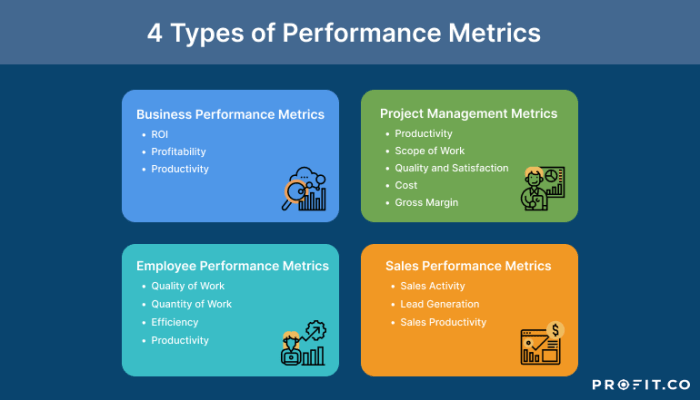Understanding Content Performance Metrics sets the stage for this enthralling narrative, offering readers a glimpse into a story that is rich in detail with american high school hip style and brimming with originality from the outset.
When it comes to analyzing digital success, content performance metrics play a crucial role in determining what works and what doesn’t in the vast landscape of online content.
Definition of Content Performance Metrics

Content performance metrics refer to the data and analytics used to measure the effectiveness and success of content across various digital platforms. These metrics help marketers understand how well their content is performing and identify areas for improvement.
Common Content Performance Metrics
- Pageviews: The number of times a page is viewed by users.
- Unique Visitors: The number of individual users who visit a page.
- Time on Page: The average amount of time users spend on a page.
- Bounce Rate: The percentage of users who leave a site after viewing only one page.
- Click-Through Rate (CTR): The percentage of users who click on a specific link.
- Conversion Rate: The percentage of users who complete a desired action, such as making a purchase or filling out a form.
Importance of Tracking and Analyzing Content Performance Metrics
Tracking and analyzing content performance metrics is crucial for digital marketers to evaluate the impact of their content strategies. By understanding how users interact with content, marketers can make data-driven decisions to optimize their campaigns, improve engagement, and drive conversions. Regularly monitoring these metrics allows marketers to adapt their content strategy based on real-time data and insights, ultimately leading to better results and a more effective digital marketing strategy.
Types of Content Performance Metrics

In the world of content marketing, there are various types of performance metrics that help businesses gauge the success of their content strategies. These metrics provide valuable insights into how well content is resonating with the target audience and driving desired outcomes.
Engagement Metrics
Engagement metrics focus on how users interact with the content. These metrics include likes, shares, comments, time spent on page, bounce rate, and scroll depth. By analyzing engagement metrics, businesses can understand the level of interest and connection their content is creating with the audience. Higher engagement rates indicate that the content is compelling and relevant to the users, leading to increased brand awareness and loyalty.
- Likes, shares, and comments: These metrics show how users are actively engaging with the content by liking, sharing, or leaving comments, indicating their interest and satisfaction level.
- Time spent on page: This metric measures the average amount of time users spend consuming the content, reflecting the content’s ability to captivate and retain audience attention.
- Bounce rate: The bounce rate indicates the percentage of users who navigate away from the page after viewing only one page, providing insights into content relevance and user experience.
- Scroll depth: By tracking how far users scroll down a page, businesses can assess the depth of engagement and identify areas of content that attract or lose user interest.
Conversion Metrics
Conversion metrics focus on the actions users take after engaging with the content. These metrics include click-through rates, conversion rates, lead generation, and sales attribution. Conversion metrics help businesses measure the effectiveness of their content in driving desired actions and achieving business goals.
- Click-through rates: This metric measures the percentage of users who click on a call-to-action or link within the content, indicating the level of interest and intent to explore further.
- Conversion rates: The conversion rate reflects the percentage of users who complete a desired action, such as making a purchase or signing up for a newsletter, showcasing the content’s ability to drive conversions.
- Lead generation: Tracking the number of leads generated from content interactions helps businesses quantify the impact of content in attracting potential customers and nurturing relationships.
- Sales attribution: By attributing sales to specific content pieces or campaigns, businesses can evaluate the content’s contribution to revenue generation and ROI.
Traffic Metrics
Traffic metrics focus on the volume and sources of traffic driven to the content. These metrics include page views, unique visitors, traffic sources, referral traffic, and organic search traffic. Traffic metrics provide insights into the reach and visibility of content across different channels.
- Page views: Page views indicate the total number of times a page has been viewed, reflecting the overall popularity and visibility of the content.
- Unique visitors: Unique visitors represent the number of distinct individuals who have visited the content, helping businesses understand the size and diversity of the audience reached.
- Traffic sources: Analyzing traffic sources (direct, organic, social, referral, etc.) enables businesses to identify the channels driving traffic and optimize content distribution strategies.
- Referral traffic: Referral traffic shows the websites or platforms that refer users to the content, highlighting potential partnership opportunities and content amplification strategies.
- Organic search traffic: Organic search traffic indicates the number of users who discover the content through search engine results, showcasing the content’s visibility and relevance in search rankings.
Key Performance Indicators (KPIs) for Content
In the world of content performance metrics, Key Performance Indicators (KPIs) play a crucial role in measuring the success of content strategies. These KPIs provide valuable insights into how well content is performing and whether it is meeting the set goals.
Essential KPIs for Content Performance
- 1. Traffic: This KPI measures the number of visitors to a website or specific content piece. It helps in understanding the reach and popularity of the content.
- 2. Engagement: Engagement KPIs include metrics like time spent on page, bounce rate, and social shares. They indicate how well the audience is interacting with the content.
- 3. Conversions: Conversion KPIs track the actions taken by users after consuming content, such as signing up for a newsletter, making a purchase, or filling out a form.
- 4. Click-through Rate (CTR): CTR measures the percentage of people who click on a link or call-to-action within the content. It helps in assessing the effectiveness of content in driving user actions.
Role of KPIs in Setting Goals and Evaluating Strategies
KPIs play a crucial role in setting specific, measurable, achievable, relevant, and time-bound (SMART) goals for content. By tracking KPIs, businesses can evaluate the success of their content strategies and make data-driven decisions to optimize performance.
Examples of KPI Utilization in Businesses
| Business | Key Performance Indicator | How it is Utilized |
|---|---|---|
| E-commerce Store | Conversion Rate | By analyzing the conversion rate, the store can identify areas for improvement in the sales funnel and optimize content to increase conversions. |
| Content Marketing Agency | Engagement Metrics | The agency uses engagement metrics to measure the effectiveness of content campaigns and tailor strategies based on audience interactions. |
| Software Company | Click-Through Rate | By monitoring the CTR of their software demo videos, the company can refine video content to encourage more users to explore their product offerings. |
Tools and Techniques for Analyzing Content Performance: Understanding Content Performance Metrics
When it comes to analyzing content performance, there are several popular tools and platforms that can help you track metrics effectively. These tools provide valuable insights that can be used to optimize your content strategy and improve overall performance.
Google Analytics
Google Analytics is a powerful tool that allows you to track various metrics related to your website’s performance, including traffic sources, user behavior, and conversion rates. By analyzing data from Google Analytics, you can gain valuable insights into how your content is performing and identify areas for improvement.
- Track key metrics such as page views, bounce rate, and average session duration to assess the performance of your content.
- Use the Behavior Flow report to understand how users navigate through your site and identify popular content.
- Set up goals and conversions to track specific actions taken by users on your site, such as form submissions or purchases.
Social Media Analytics Tools, Understanding Content Performance Metrics
Social media platforms like Facebook, Twitter, and LinkedIn provide built-in analytics tools that can help you track the performance of your content on these channels. These tools offer valuable insights into engagement metrics, audience demographics, and content reach.
- Monitor metrics such as likes, shares, comments, and impressions to gauge the impact of your social media content.
- Use audience insights to understand the demographics and interests of your followers and tailor your content accordingly.
- Track referral traffic from social media to your website to measure the effectiveness of your social media marketing efforts.
Heatmap Tools
Heatmap tools like Crazy Egg or Hotjar provide visual representations of user behavior on your website, allowing you to see where users are clicking, scrolling, and spending the most time. By analyzing heatmap data, you can optimize your website layout and content placement for better performance.
- Identify areas of high user engagement on your website and optimize content placement for maximum visibility.
- Use scroll maps to see how far users are scrolling down a page and adjust content length accordingly.
- Analyze click maps to understand which elements are attracting the most user clicks and optimize calls-to-action for better conversion rates.












